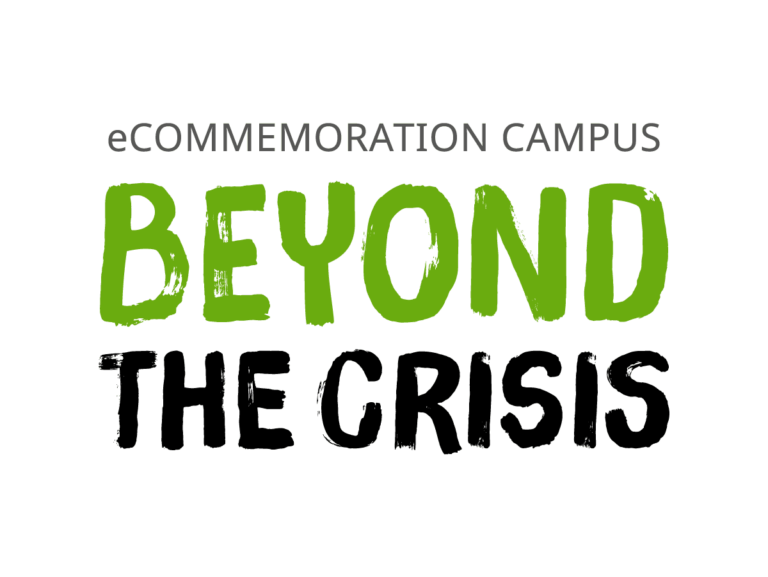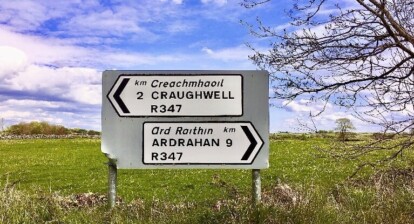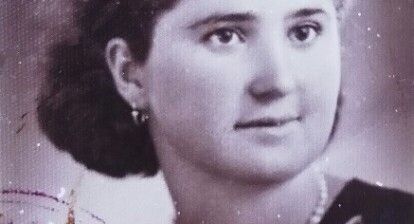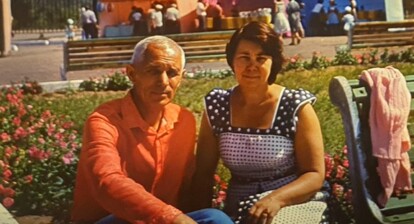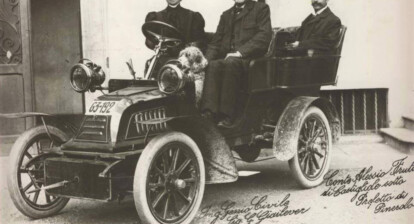Drug Addiction in Ireland
25 Years After Veronica Guerin
In 1996, Irish journalist Veronica Guerin was murdered for speaking out against drug cartels and illegal drug trafficking. Her death caused waves of grief across Ireland. How much has really changed since then? According to statistics, drug abuse in Ireland has become much worse rather than better.
By Neasa, participant of the eCommemoration Campus 2020
“
I am letting the public know exactly how this society operates.

The Veronica Guerin Memorial in Dubh Linn gardens, Dublin Castle [2]
1
Veronica the Journalist
Veronica Guerin was an Irish crime reporter from Dublin who made it her mission to investigate drug trafficking and organised crime gangs in Dublin, Ireland. Her journalistic work led to her to question several criminals for information. Because there were strict laws that made it illegal for reporters to identify suspected wrongdoers by name, she always identified the subjects of her articles by their nicknames, such as 'The Monk' or 'The Penguin.'
On numerous occasions, her life, and that of her family was threatened. She was even shot at in her own home in early 1995, but even so she refused to stop reporting on the illegal drug trade.
On numerous occasions, her life, and that of her family was threatened. She was even shot at in her own home in early 1995, but even so she refused to stop reporting on the illegal drug trade.
Death on a Motorcycle
Later that year, Veronica attempted to question John Gilligan, an ex-convict, who had amassed a huge amount of wealth without any visible source of income. He beat her up and threatened to harm her young son and kill her if she tried to expose him. Nevertheless, she didn't allow this to intimidate her into silence and continued her investigations into the illegal drug trade.
On June 26 1996, Guerin was stopped at traffic lights while driving through Dublin. Two men on a motorcycle drove up beside her and shot her five times, killing her instantly, and then drove away before they could be apprehended.
On June 26 1996, Guerin was stopped at traffic lights while driving through Dublin. Two men on a motorcycle drove up beside her and shot her five times, killing her instantly, and then drove away before they could be apprehended.
Catalyst for Change
Her death caused huge outrage across the country, and was also the long-awaited catalyst for change. Newspapers began offering better security to journalists working on dangerous stories, and the Irish government introduced new stricter measures aimed at cracking down on organized crime, making it easier for the police to pursue cases against crime bosses. In response to her murder, the Criminal Assets Bureau (CAB) was set up to disrupt crime bosses' activities by seizing their assets.
Most importantly, Guerin's death caused a series of citizen groups to spring up in some of Dublin's poorest neighbourhoods where the drug trade was the most prevalent. Guerin is remembered for her sheer determination to speak out about the truth and to do what was right, making her a hero to many people in Ireland.
“
"Veronica stood for freedom to write. She stood as light, and wrote of life in Ireland today, and told the truth. Veronica was not a judge, nor was she a juror, but she paid the ultimate price with the sacrifice of her life."
2
Drug Abuse in Ireland
There was very little illegal drug use in Ireland until the 1970s, when cannabis and LSD gained popularity among students in Dublin. It wasn't until the 1980s that there was a sudden explosion of drug use among young people, particularly in the capital. This mainly occurred among more socially deprived communities and was primarily heroin-based.
It became a major concern within communities, especially because there was a large spike in drug-related violence, which had never been seen before. This gained a lot of attention from the media and politicians.
It became a major concern within communities, especially because there was a large spike in drug-related violence, which had never been seen before. This gained a lot of attention from the media and politicians.

Two capsules of morphine sulphate [3]
Rise in Numbers
Over the past few decades, Ireland has opened up in many ways, and so has the amount of drugs in the country. There was a big rise in cocaine use in the mid-1990s to early 2000s, also known as the "Celtic Tiger period", and between 2004 and 2016, the number of deaths caused by drug poisoning increased by 71%.

The majority of poisoning deaths in Ireland in 2016 involved polydrugs, which are a combination of different substances, and are seen as a huge risk factor for fatal overdoses. In 2004, an average of two drugs were involved in polydrug poisoning deaths, but in 2016, the average number rose to four.

Neil Wilson is a member of the Western Drug & Alcohol Task force, an organisation in Western Ireland that educates schools and communities on the national problem of drug abuse. Asked about the present status of drug abuse in Ireland he mentioned another problematic drug: alcohol.
“
"I have to be very careful what I say sometimes, but I think it's fair to say that Ireland has always had a reputation for drinking. Some people are proud of that and some people say it's a slur on our national character. Either way, we've always had drug use, going back hundreds of years when people in Connemara were making a rather strange brew, poitín. It's always been a part of society."
What is Poitín?

Poitín is an ancient farm-based spirit that's made in a single pot still, dating back to the 6th century. It's based on the Irish word for 'little pot', pota. It's traditionally made with starchy crops grown on the farm, which have since been limited by statutory definition to potatoes, cereals, grain, whey, sugar beet and molasses. Poitín was later made completely illegal in 1661, as the government wanted the ability to tax all alcohol and couldn't easily tax farm liquor.
It wasn't until 1997 that it was legalised again, though the illegal form was still homebrewed secretly, and became quite popular. Over half a dozen modern liquor companies have entered the poitín market. It's generally been made available everywhere, though connoisseurs insist that the trade version shouldn't be held in the same regard as the farm-produced poitíns. It is also not regulated properly and has often caused serious health issues for those who consume it regularly.
A New Perspective
Alcohol abuse is not a new phenomenon in Ireland. But one of the biggest changes in more recent times is the viewing of alcohol as a drug. The task force sees drugs and alcohol to be more or less the same thing.
According to Neil Wilson, "even ten, fifteen years ago, the alcohol lobby was very keen to separate them out, and not see alcohol as a drug. Separate reports and systems were used for the problem of alcohol and drugs. That has all changed now. We used to be the Western Region Drugs Task Force. Now we're the Western Drugs & Alcohol Task Force."
The same can be said for prescription drugs, which are perfectly legal. They too can be seriously misused, and the recognition of that as part of the drugs issue in Ireland has been a fundamental change of thinking in the last 25 years. Currently, the most common drugs that are misused throughout Ireland are depressants.
According to Neil Wilson, "even ten, fifteen years ago, the alcohol lobby was very keen to separate them out, and not see alcohol as a drug. Separate reports and systems were used for the problem of alcohol and drugs. That has all changed now. We used to be the Western Region Drugs Task Force. Now we're the Western Drugs & Alcohol Task Force."
The same can be said for prescription drugs, which are perfectly legal. They too can be seriously misused, and the recognition of that as part of the drugs issue in Ireland has been a fundamental change of thinking in the last 25 years. Currently, the most common drugs that are misused throughout Ireland are depressants.
Teenage drug addicts [4]
3
What Is Being Done About It?
One of the key responses to the rise of drug abuse and related crime in the 1980s was the establishment of locally-based drug task forces. These were so successful that they were expanded to form larger Regional Task Forces like the mentioned Western Drugs & Alcohol Task Force, which was originally set up 12 years ago.
These task forces employed a group of people who were well-informed about the situations in their communities. Their job was to introduce measures that were appropriate for their respective areas, such as education, prevention, services and needle exchanges. To reduce the harm caused by drug and alcohol use, cooperations between organisations of each area were established.
These task forces employed a group of people who were well-informed about the situations in their communities. Their job was to introduce measures that were appropriate for their respective areas, such as education, prevention, services and needle exchanges. To reduce the harm caused by drug and alcohol use, cooperations between organisations of each area were established.
“
"Obviously they couldn't do the really big-scale things, because many politicians believed that it's only when they put major investments in a place that they could really begin to tackle the drug situation. Deprivation is one of the main reasons why there was a lot of drug use, and task forces can't fund millions and millions for that"
Cross-Community Cooperation
It is important for parents in particular to try to strike a balance between taking a hard line approach with their children on the one hand or having a laissez-faire attitude towards drug use on the other.
Different organisations, including the HSE, educational groups, communities, counselling and support groups and the police came together locally to fight against the growing drug trade. They did this by looking at their policies and filling in the gaps where certain statutory or voluntary services were missing.
These task forces also give vital advice to teachers and parents about how to speak to young people about drug abuse and drug-related crime.
These task forces also give vital advice to teachers and parents about how to speak to young people about drug abuse and drug-related crime.
Keeping Communication Open
A balance can be achieved by keeping communication open with children, making drug abuse a topic that parents can easily talk about and also by putting vital supports in children's lives to prevent drug use in the first place.
These local drug task forces have been deemed a success, as they are making a useful contribution to communities. It is left up to the local people they employ to decide how best to use the resources at their disposal.
It is hoped that organisations like these will help to curb the rising rate of drug abuse in Ireland. It is the people who fight back who represent hope during this difficult time in Ireland. Through their work they are keeping Veronica Guerin's memory alive and continuing the work that she started.
It is hoped that organisations like these will help to curb the rising rate of drug abuse in Ireland. It is the people who fight back who represent hope during this difficult time in Ireland. Through their work they are keeping Veronica Guerin's memory alive and continuing the work that she started.
“
"She wanted to do right by children and make a better place for all."
Credits
Internet:
https://people.com/archive/killed-for-her-courage-...
https://womensmuseumofireland.ie/articles/veronica...
https://www.hrb.ie/fileadmin/2._Plugin_related_fil...
https://www.irishwhiskeymuseum.ie/news/irish-poitin/
Pictures:
Header picture: "Drug addiction" by Chris Yarzab,
[2] Veronica Guerin Memorial, by infomatique, CC BY-SA 2.0
[3] 2 capsules of morphine (5mg/10mg), by GeoTrinity, CC BY-SA 4.0
[4] Teenage Drug Addicts by Artem - CC BY-SA 2.0
A Selection of Legal Irish and Celtic Poitin or Poteen Bottles Taken in a Poitin Bar by Ethanbentley, CC BY-SA 3.0
Graph 1 - Made with Infogram (Private)
Graph 2 - Made with Infogram (Private)
Internet:
https://people.com/archive/killed-for-her-courage-...
https://womensmuseumofireland.ie/articles/veronica...
https://www.hrb.ie/fileadmin/2._Plugin_related_fil...
https://www.irishwhiskeymuseum.ie/news/irish-poitin/
Pictures:
Header picture: "Drug addiction" by Chris Yarzab,
[2] Veronica Guerin Memorial, by infomatique, CC BY-SA 2.0
[3] 2 capsules of morphine (5mg/10mg), by GeoTrinity, CC BY-SA 4.0
[4] Teenage Drug Addicts by Artem - CC BY-SA 2.0
A Selection of Legal Irish and Celtic Poitin or Poteen Bottles Taken in a Poitin Bar by Ethanbentley, CC BY-SA 3.0
Graph 1 - Made with Infogram (Private)
Graph 2 - Made with Infogram (Private)

